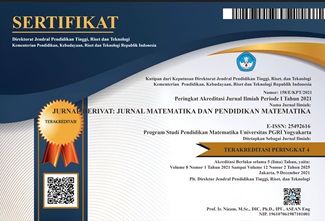Penyetaraan Horisontal Perangkat Tes Ujicoba Ujian Nasional Matematika SMA Program IPA Di SMAN Kota Yogyakarta Tahun Pelajaran 2009/2010
DOI:
https://doi.org/10.31316/j.derivat.v2i1.118Abstract
Penelitian ini bertujuan menentukan kesetaraan tes ujicoba Ujian Nasional matematika SMA program IPA d SMAN Kota Yogyakarta tahun ajaran 2009/2010. Sumber data berasal dari lembar jawaban siswa kelas XII IPA di SMAN kota Yogyakarta yang mengikuti ujicoba Ujian Nasional Matematika IPA tahun pelajaran 2009/2010 putaran 1, 2, dan 3 dengan jumlah sampel 1396. Karaketeristik tes dilakukan Bilog MG, Analisis untuk kesetaraan meliputi: analisis varians untuk menguji kesamaan rata-rata, uji Tukey untuk uji pasangan, dan uji Levene untuk menguji homogenitas varians. Proses penyetaraan menggunan kurva karakteristik dari Haebera dengan bantuan program Excel 2007. Hasil penelitian menunjukkan bahwa secara bersama-sama tes putaran 1, 2, dan 3 tidak paralel. Tes putaran 1 dan putaran 2 tidak paralel dengan persamaan kesetaran tes putaran satu (X) ke putaran dua (Y) adalah = , demikian juga dengan tes putaran 1 dan putaran 3 juga tidak paralel dengan persamaan kesetaraan soal putaran satu (X) ke putaran tiga (Z) adalah = .
Â
Kata Kunci: Penyetaraan horizontal, test matematika
Downloads
Published
Issue
Section
Citation Check
License
Authors who publish with this journal agree to the following terms:
-
Authors retain copyright and grant the journal right of first publication with the work simultaneously licensed under a Creative Commons Attribution-ShareAlike 4.0 International License that allows others to share the work with an acknowledgment of the work's authorship and initial publication in this journal.
- Authors are able to enter into separate, additional contractual arrangements for the non-exclusive distribution of the journal's published version of the work (e.g., post it to an institutional repository or publish it in a book), with an acknowledgment of its initial publication in this journal.
- Authors are permitted and encouraged to post their work online (e.g., in institutional repositories or on their website) prior to and during the submission process, as it can lead to productive exchanges, as well as earlier and greater citation of published work (See The Effect of Open Access).







